 Cremant d’Alsace is the sparkling wine that Champagne makers drink! If you haven’t tasted it yet you have a treat in store.
Cremant d’Alsace is the sparkling wine that Champagne makers drink! If you haven’t tasted it yet you have a treat in store.
Cremant d’Alsace Joseph Pfisner is traditionally made, a pale yellow colour with a dense, very fine mousse lasting to the last sip in the glass. It is very fruity on the nose with definite hints of apricots and plums.
It is light, fresh and puts a “zing” in your palate! It’s made from Pinot Noir, Pinot Blanc and Pinot Auxerrois grapes and is 12.5%.
If you would like to try a sparkling wine that stands out in superiority amongst the rest this is the bottle for you. It’s not over priced at £7.99 and you can find it on my website www.bordeaux-undiscovered.co.uk.
In Alsace Cremant d’Alsace is used instead of Champagne at all celebrations and festivities. It is made using the methode champenoise with regional grapes.
The AOC conferred upon Cremant d’Alsace on August 24, 1976, guarantees that it comes only from Alsace and is produ ced in strict conformance with the traditions and standards of the local growers.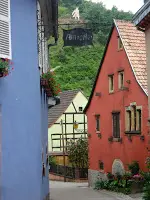
The Alsatians place great importance on terroir and distinctions amongst grapes. The principal grape is the pinot blanc (also called klevner), but riesling, pinot gris, and chardonnay may also be used.
Whichever grapes are to be used, they are picked several days before the official opening date of the wine harvest.
The grapes by law must be transported in non-watertight boxes. They are then pressed often with the stems still on, a tradition in the area that is said to give the wine an added boost of tannin.
 After th e first fermentation in the vats, the wine begins a second through the methode champenoise, where it gains its fine bubbles and elegant character. This method is very painstaking as experts check the wine on a daily basis for over 2 years.
After th e first fermentation in the vats, the wine begins a second through the methode champenoise, where it gains its fine bubbles and elegant character. This method is very painstaking as experts check the wine on a daily basis for over 2 years.
The bottles are first laid flat on their sides for several months until the wine is deemed sufficiently aged. They are then placed in an A-shaped rack called a pupitre, which holds them at first at about a 30° angle facing neck down.
A master craftsman called a remueur turns each and every bottle daily and gradually tilts it to a steeper angle until they are nearly vertical and the sediment has slid down into the neck.
The next step is to freeze the neck of the bottle in the process of removing the cork without disturbing the wine. As the cork is removed it brings with it the unwanted sediment. Each bottle is checked to ensur e the purity of its contents, then stopped with the traditional cage-shaped champagne cork and wrapped in gold.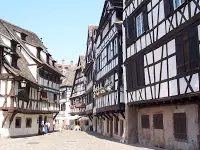
Alsace lies on a fertile plain between the Vosges Mountains and the River Rhine and its wine accounts for 25% of the regions agriculture.
Documents in the archives of the regional capital of Strasbourg attest to the fact that, before the year 900 AD, at least 160 wine producers were at work in the region.
The vines are protected by the Vosges Mountains and the rainfall is very light there. Th ere are 8,500 growers who cultivate 14,000 hectares to produce upwards of 10 million cases per year.
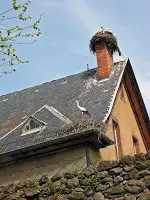 Alsace wines are predominantly white and have a strong Germanic influence. It produces some of the world’s most noted dry reislings and is the only région in France to produce mostly varietal wines identified by the names of the grapes. Alsace is also the main beer-producing région of France and its breweries are household names – Kronenbourg, Fischer, Heineken, Meteor, and Kanterbrau. Schnapps is also traditionally made in Alsace.
Alsace wines are predominantly white and have a strong Germanic influence. It produces some of the world’s most noted dry reislings and is the only région in France to produce mostly varietal wines identified by the names of the grapes. Alsace is also the main beer-producing région of France and its breweries are household names – Kronenbourg, Fischer, Heineken, Meteor, and Kanterbrau. Schnapps is also traditionally made in Alsace.
Alsatian cuisine is strongly influenced by the Germanic culinary traditions and tends to use a great deal of pork. The dishes ar e substantial and Alsatians are famous for their generous portions. Traditional dishes include sauerkraut and plum tarts. Gingerbread is another favourite there.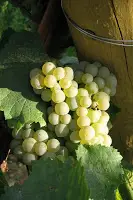
No other region in France produces as many varieties of fruits, wild or cultivated, than Alsace. Peaches, pears, raspberries, plums, Mirabelles (a yellow-skinned plum) and cherries are just a few of the more commonly found fruits.
The Alsatians also love spices, not only in desserts or with fruit but also as a flavouring for cheese: Munster with cumin and wine is a popular one.
Spices were all the rage in Europe in the Middle Ages. This rage for spices eventually died out in other parts of France by the 17th century but not in Alsace. They have continued to play an important part in the Alsatian cuisine up to today.
(From Sue . . .)
If you ar e looking for a traditional Alsace dessert then this one is delicious. Try the Cremant d’Alsace with it – it makes a superb combination!
Grape Tart with Walnuts
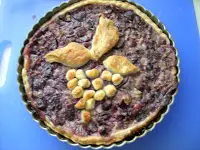 1 refrigerated pie crust
1 refrigerated pie crust- 2-1/4 lbs. red or white seedless grapes (Chasselas or Muscat grapes are used in Alsace)
- 2 tbsp Marc d’Alsace or other brandy
- 1/2 cup sugar
- 1/2 cup ground walnuts
- 5 tbsp milk
- 5 tbsp crème fraîche
- 3 eggs
 icing sugar for dustingSoak the grapes in the Marc d’Alsace and the sugar for several hours. Heat the oven to 400°F. Roll out the pastry and line a 10-inch tart pan, with a removable bottom, and prick the bottom. Line the pastry with foil and pie weights and blind bake for about 10 minutes.
icing sugar for dustingSoak the grapes in the Marc d’Alsace and the sugar for several hours. Heat the oven to 400°F. Roll out the pastry and line a 10-inch tart pan, with a removable bottom, and prick the bottom. Line the pastry with foil and pie weights and blind bake for about 10 minutes.
Remove the foil and the weights and bake an additional 5 minutes or until lightly golden. Spread the ground walnuts on the bottom of the tart. Strain the grapes, reserving the juice, and arrange them on top of the nuts.
Whisk the juice with the milk, crème fraîche and eggs until it is thick and mousse-like. Gently spoon the egg mixture over the grapes. Bake the tart for 30-35 minutes or until it is golden. Cool the tart. Dust lightly with confectioner’s sugar, slice and serve.

